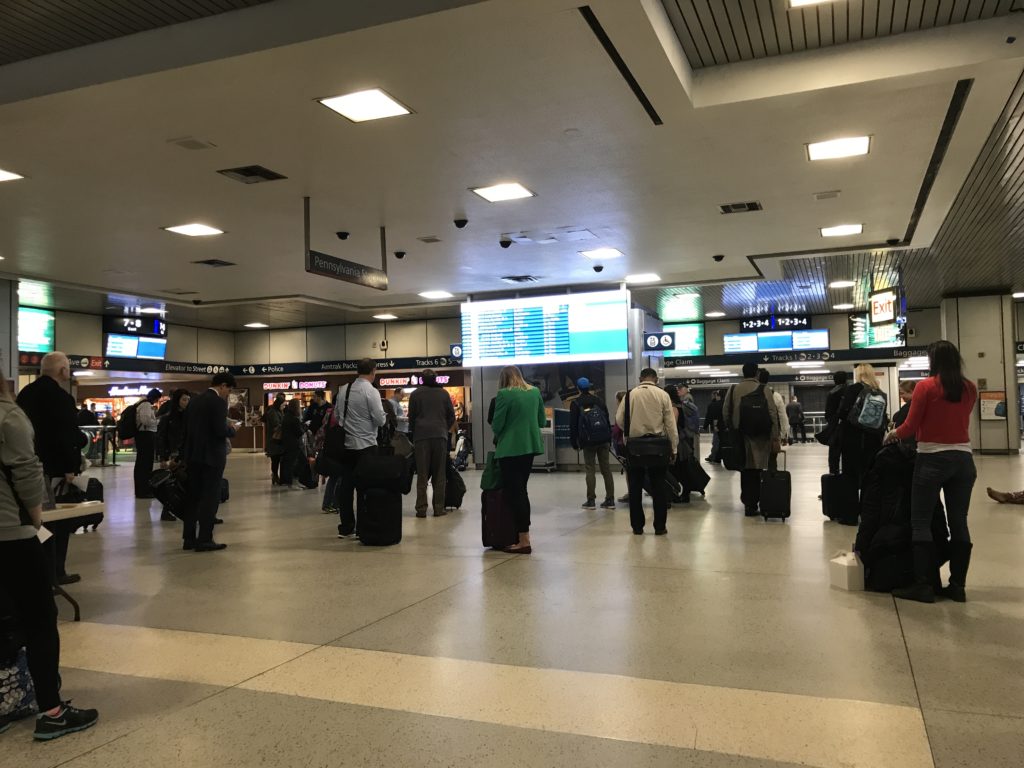Amtrak‘s current plans to fix problems at Penn Station during the summer of 2017 will reduce the number of morning rush hour trains from New Jersey into New York by nearly two-thirds periodically, causing the potential for massive overcrowding on remaining trains in service.
Steven Santoro, executive director of NJ Transit, New Jersey’s public transportation corporation, warned a New Jersey Assembly committee that these plans would be “unacceptable” to New Jersey commuters. Although Santoro spoke before he had had a chance to review the full details of the Amtrak work plan, he compared the planned weekday reductions in service to equivalent reductions that Amtrak instigated after an April 3, 2017, derailment. Those reductions resulted in passenger delays and overcrowded trains.
Amtrak‘s post-derailment schedule decreased the number of trains that ran from New Jersey to Penn Station between the peak hours of 6:00 and 10:00 a.m. from 63 to as few as 25 per day, imposing holiday scheduling on weekday morning rush hours.
If the Amtrak proposal did indeed result in a summertime reduction to 25 trains running into Penn Station each weekday morning, Santoro said, “that is not acceptable because of overcrowding” despite the addition of trains and buses.
Riders on the New Jersey side of the route learned from NJ Transit that weekday routes would experience delays of at least 15 minutes, with weekend routes subject to at least 30-minute delays. These delays were likely to continue “indefinitely.”
When Amtrak officials announced the fundamentals of their Summer 2017 repair plans for Penn Station, those plans targeted a junction at which trains emerge from tunnels under the Hudson River. At that junction, dual tracks branch out to a total of 21 lines. After testimony before the Joint Legislative Oversight Committee of the New Jersey Assembly, Amtrak CEO Wick Moorman called the planned upgrades “an effective plan to address the renewal needs,” adding that Amtrak would confer with both NJ Transit and the Long Island Rail Road about the summer schedule. Moorman added that at least two or three times during the work schedule, some of the repairs would begin on weekends and extend into the week.

New York Penn Station
New Jersey Assemblywoman Elizabeth Maher Muoio (D-Mercer) called on NJ Transit to enhance its communications of scheduling disruptions and delays to give commuters more advance notice of impending problems. She indicated that news of problems often reaches commuters too late to make other arrangements. Maher Muoio further suggested that NJ Transit “overhaul your communication system” at the same time that Amtrak is renovating its trackage.
Santoro, NJ Transit’s executive director, responded to Maher Muoio’s assessment of communications deficiencies, stating that NJ Transit is implementing an enhanced social media presence to provide riders with more and quicker access to route details.
Santoro also replied to New Jersey State Senator Loretta Weinberg (D-Bergen), who inquired whether Amtrak service would suffer a reduction similar to the changes that will affect NJ Transit. Santoro indicated that “that level of discussion” had not yet occurred. He pointed out that he already has entered into discussions with ferry operators about service increases to offset the needs of displaced train passengers affected by trackage under repair at Penn Station.
NJ Transit’s fleet of buses, trains, and light-rail vehicles carries more than 220 million passengers each year in a 5,325-square-mile service area. The agency serves as the third-largest provider of bus, rail, and light-rail transit in the United States, with a fleet that includes 2,027 buses, 711 trains, and 45 light-rail vehicles.



 Jamie Larounis is an avid traveler, blogger and miles/points educator. Traveling well over 100,000 miles a year and staying in hotels for over 100 nights, he leverages miles, points and other deals to fly in first class cabins, and stay in 5-star hotels. The Forward Cabin shares his experiences, musings, reviews, tips, tricks, resources and industry news with you, the fellow traveler.
Jamie Larounis is an avid traveler, blogger and miles/points educator. Traveling well over 100,000 miles a year and staying in hotels for over 100 nights, he leverages miles, points and other deals to fly in first class cabins, and stay in 5-star hotels. The Forward Cabin shares his experiences, musings, reviews, tips, tricks, resources and industry news with you, the fellow traveler.
Leave a Reply